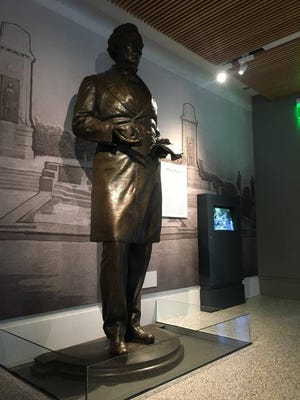When a bronze Confederate needed to retire, University of Texas found a home
 Rick Jervis
Rick Jervis
AUSTIN – After enduring decades of graffiti, bird droppings, searing debates and court hearings, the bronze statue of Jefferson Davis was removed two years ago from its outdoor perch at the South Mall at the University of Texas at Austin.
Today, it enjoys a comfy – if less prominent – retirement just inside the main entrance of UT’s Dolph Briscoe Center for American History, surrounded by papers and interactive video displays describing its life.
Deadly violence at a white nationalist rally in Charlottesville last week reignited the debate over whether or not to remove the hundreds of Confederate statues and memorials across the USA. Baltimore, Durham, N.C., Memphis, Tampa, Madison, Wis., Louisville and Los Angeles have all seen monuments and memorials removed or are considering removing them.
Often, the controversy doesn’t stop when the statues are taken down. What to do with the removed artifacts often fuels more debate, as New Orleans officials discovered when it removed four Confederate memorials from public areas earlier this year. The statues were later found in a storage yard in New Orleans East, redrawing the ire of those who supported keeping the monuments where they were.
At UT, the decision to transfer the 8-1/2-foot-tall, 2,000-pound statue of the former president of the Confederacy to the history center rather than store or destroy wasn't without controversy, but it represents one possible solution to the debates roiling the nation over what to do with Confederate statues, said Don Carleton, the center’s executive director.
“I think this is the answer,” Carleton said. “They are pieces of art; destroying that is like burning books. They need to be preserved and they belong in museums.”

Calls to bring down UT's Jefferson Davis statue, which overlooked the Austin campus for eight decades, began shortly after the 2015 shooting inside a Charleston, S.C., church. In that incident, a 21-year-old white supremacist shot and killed nine people and injured three others during a prayer service inside the predominately African-American church.
UT officials formed a task force, studied the issue and decided to remove the Davis statue, Carleton said. Three other Confederate statues on campus – Gens. Robert E Lee and Albert Sidney Johnston and Postmaster General John H. Reagan – were allowed to stay.
What to do with the Davis statue created more questions: Moving it to another location would likely spur calls for removal and destroying it seemed wrong, as well, he said. Carleton suggested giving it a home at the Briscoe Center.
"The point is, we will not be putting him in our building as some of sort of shrine to Jefferson Davis, but as an educational experience and point of discussion," he said.
Using old letters, diary entries and original sketches, the exhibit – titled "From Commemoration to Education" – tells the story of how the statue came to be and why it was later removed from its original spot on UT campus. In 1919, George Washington Littlefield, a Confederate veteran and prominent university donor, commissioned the Davis and other Confederate statues. Pompeo Coppini, an Italian immigrant living in Chicago, was hired to sculpt the statues.
The letters show how the Davis and other statues sparked controversy even then, with some university officials questioning their proposed prominence on campus. "How can a group composed of men from only one section stand for a united nation?" one professor wrote in 1921 after reviewing Coppini's work-in-progress. The statues were erected in 1933.
The centerpiece of the exhibit, which opened earlier this year, is the towering Davis statue itself, dressed in an overcoat and holding a sheath of papers with his left hand. His right is hand opened and slightly curled, as if in debate.
Groups of university students and enthusiasts have visited the exhibit. The center expects more as fall classes resume later this month.
Marshall Davis, a spokesman with the Sons of Confederate Veterans, Texas Division, which took the university to court to keep the statue in its outdoor location, toured the exhibit recently.

While Davis said he is glad the statue "wasn’t melted down to make college rings," he felt the exhibit gave short shrift to Davis' life. His four years as leader of the Confederacy were a fraction of a life that included stints as U.S. Secretary of War, a U.S. senator and military strategist, he said.
"To move that statue away [from its original site] besmirches all of Davis' body of work," he said.
Center officials purposely kept the exhibit focused on the creation and removal of the statue, said Ben Wright, associate director at the center and the exhibit's curator.
The statue itself – from the choice of Davis' dress to his posture to the way it was cast – contains important historical information that should be preserved, Wright said.
"The question is whether you preserve this historical information in a commemorative setting or in a educative setting," he said. "The presence of the statue in an educational exhibit, as opposed to a place of honor, underlines that Davis, as well as his ideas and actions, are no longer commemorated by the university."